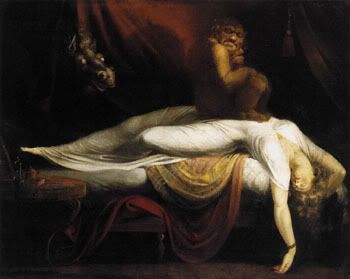Why am I here to relate the destruction of the best hope and the purest creature on earth? She was there, lifeless and inanimate, thrown across the bed, her head hanging down and her pale and distorted features half covered by her hair. Everywhere I turn I see the same figure--her bloodless arms and relaxed form flung by the murderer on its bridal bier. Could I behold this and live? Alas! Life is obstinate and clings closest where it is most hated. For a moment only did I lose recollection; I fell senseless on the ground. - Victor Frankenstein after the murder of Elizabeth by the creature.
As I was perusing litgothic, I came across some information regarding the inspiration for Mary Shelley's description of Elizabeth's death. Apparently, it was based on a painting called The Nightmare (of which there are two versions) by an English artist called Henry Fuseli.

You can see both versions of the painting in a larger scale at the Art Renewal Center along with a myriad of other works. I'm particularly fond of the one entitled Silence.





4 comments:
Nightmare in Danish translates to Mareridt which means ridden my Maren (Maren meaning both a horse and a female name)
that should read 'by Maren'
Interesting. Even though it translates a bit differently, does it refer to bad dreams?
In the old days Maren was a common name for witches in folk tales as well, to have a bad dream was termed to be ridden by Maren (a witch) during the night.
Post a Comment